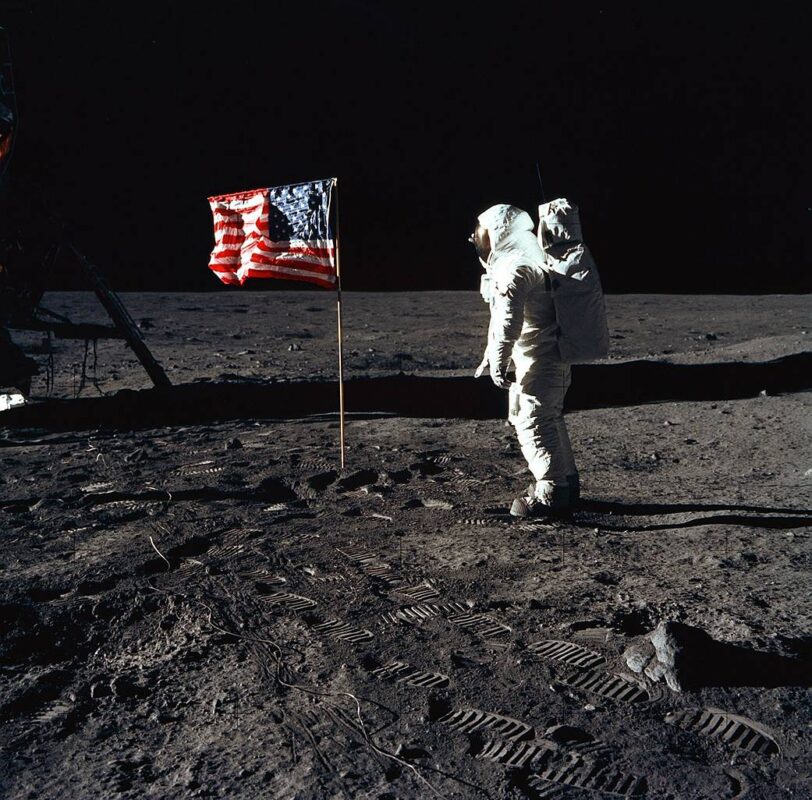July 20, 1969, marked a historic moment for humanity. It was the day when Apollo 11, a United States spacecraft, accomplished the extraordinary feat of landing on the moon, making it the first manned mission to reach Earth’s celestial neighbor. This monumental event not only represented a significant leap in space exploration but also a testament to the boundless determination and ingenuity of humankind. In this blog, we embark on a journey to relive the awe-inspiring mission, the first step on the moon, and the profound impact it had on our civilization.
The Apollo 11 Mission
The Apollo 11 mission was the culmination of years of research, technological advancements, and relentless dedication by NASA’s brilliant scientists, engineers, and astronauts. The mission was led by Commander Neil Armstrong, Command Module Pilot Michael Collins, and Lunar Module Pilot Edwin “Buzz” Aldrin.
Launched from Kennedy Space Center on July 16, 1969, the Apollo 11 spacecraft embarked on a remarkable journey towards Earth’s natural satellite. The mission had two primary components: the command module (Columbia) and the lunar module (Eagle). The command module was responsible for orbiting the moon, while the lunar module had the monumental task of landing on the moon’s surface and bringing the astronauts back to the command module.
The Journey to the Moon
The journey to the moon was a complex and carefully orchestrated endeavor. The spacecraft traveled a distance of approximately 240,000 miles (386,000 kilometers) to reach the lunar surface. It took four days to travel from Earth to the moon, during which the astronauts had to endure a mixture of excitement, nervousness, and an unwavering commitment to the mission.
While en route, the astronauts conducted several tasks, including navigational checks, course corrections, and communication with mission control. They also had to adapt to the microgravity environment of space, which posed unique challenges to their physical well-being.
The Lunar Landing: One Small Step for Man
On July 20, 1969, the world watched in anticipation as the lunar module, piloted by Neil Armstrong and Buzz Aldrin, separated from the command module and began its descent towards the moon’s surface. The landing site, known as the Sea of Tranquility, was carefully selected for its relatively smooth surface and lack of hazardous boulders.
The tension was palpable as Armstrong piloted the lunar module manually to avoid a field of large rocks near the intended landing site. As fuel levels dwindled, the “Eagle” gently touched down on the lunar surface with just seconds of fuel to spare. At 20:17 UTC, Neil Armstrong transmitted the legendary words, “The Eagle has landed,” signifying the successful touchdown.
One Giant Leap: Neil Armstrong’s First Step
Several hours after the landing, the world held its breath as Neil Armstrong prepared to take humanity’s first step on the moon. Stepping onto the lunar surface, he immortalized the moment with the famous words, “That’s one small step for [a] man, one giant leap for mankind.” It was a moment that transcended boundaries and united people around the globe in awe and wonder.
Buzz Aldrin soon joined Armstrong on the moon, and together they performed experiments, collected samples, and raised the American flag to mark their presence. The two astronauts spent approximately two and a half hours on the lunar surface, an experience that expanded our understanding of the cosmos and our place within it.
Legacy and Impact
The first moon landing was a defining moment for humanity. It showcased our capacity for innovation, bravery, and the desire to explore the unknown. The Apollo 11 mission provided crucial data that advanced scientific understanding and paved the way for subsequent space missions.
Moreover, the moon landing had a profound impact on society and culture. It inspired generations of young minds to pursue careers in science, technology, engineering, and mathematics (STEM). It symbolized what humanity can achieve when united, encouraging global collaboration and cooperation.
In Conclusion, the Apollo 11 mission remains one of the most significant accomplishments in human history. It exemplifies the power of dreams, the strength of human spirit, and the relentless pursuit of knowledge. As we look back on that fateful day in July 1969, we are reminded of our capacity to achieve the seemingly impossible and the importance of exploring beyond the boundaries of our own planet.
The legacy of Apollo 11 continues to inspire us, reminding us that with determination and vision, humanity can reach for the stars and make its mark on the universe. As we look to the future, the first moon landing serves as a timeless reminder of what we can achieve when we strive together for a common goal.


